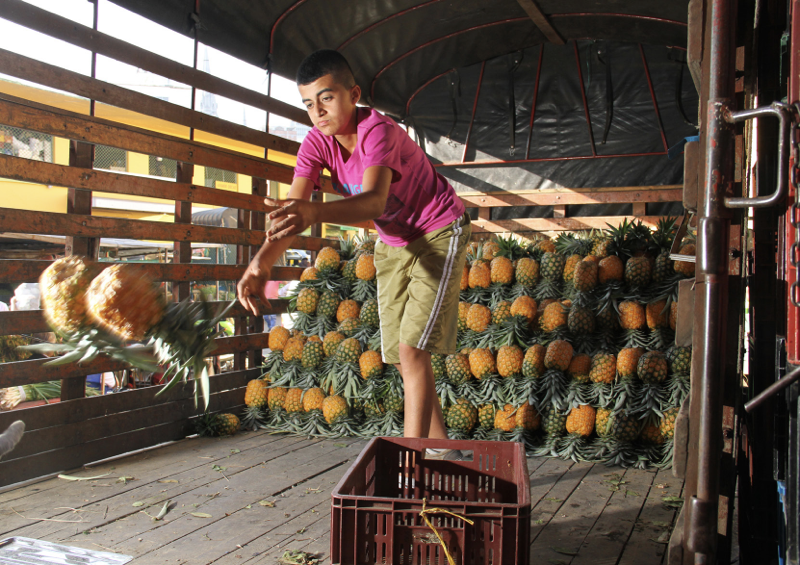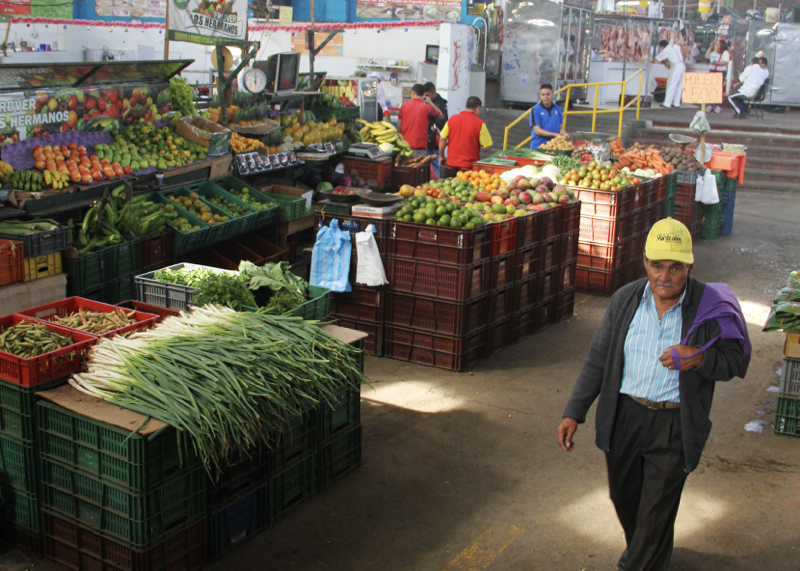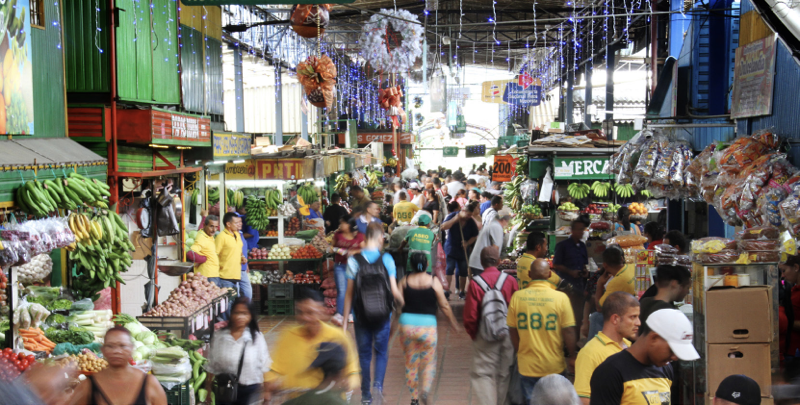Gastronomy and Meeting Places
A photographer visits the marketplaces of four Colombian cities and through his lens, finds a lively, colorful, delicious culture. This coming and going of merchants, farmers and tourists takes on a special energy during breakfast and lunch.
When touring the country’s market places, a broad picture of Colombian life can be seen: farming crops, fishing, animal raising; transportation by mule, Jeep or large truck transport; the living economy of trade; the color of the fruits, the odors and flavors of an entire country under one roof, come together every day before the first ray of sunshine at dawn.
This commercial dynamic extends beyond noon and changes its pace at lunchtime, one of the moments where the varied Colombian gastronomic habits unfold with greater transparency. There is something transversal to the culture, the economy and the provisions of all the marketplaces of the country, but these instances also show the nuances and contrasts typical of each region.
In some of these farmers’ markets a typical breakfast with tamales can be found next to the bulteros (men carrying heavy bags), of the square for COP 7,000 (USD 2.30). A few feet away a gourmet lunch prepared with innovative cooking techniques is available to the tune of a Cuban melody and a good glass of wine for the price of COP 65,000 (USD 20). The hot climate of the Pacific region can be tempered in Cali with a lulada, or the exhaustion at the end of the day in Medellin can be recharged with the energy of a substantial mazamorra.
Despite the contrasts, warmth, good energy, attentive service and satisfaction experienced by farmers, merchants and restaurant owners are shared in all the marketplaces of the country, sharing the fruits of their labor and making into their livelihoods the products of the both Colombian sea and land. This is how a day is experienced through the lens of a camera in each of the country’s main marketplaces.

La Minorista Farmers’ Market
Medellin
Founded in August 1984, La Minorista, as it is popularly known, was the replacement of El Pedrero, the farmers’ market in a nearby area that still exists today; the merchants were relocated to the new market place in order to meet demand in the northern, eastern and central eastern sectors of the city.
Its central location makes it an obligatory route for the people of the communes who travel towards the Aburra Valley. The enormous area of 26,000 square meters and its 3,332 commercial premises have made La Minorista a regulatory market that, despite its name serves as a wholesale distributor for much of Medellin.
On a market day such as Sunday, the square welcomes around 25,000 people among merchants, workers and visitors. As we walk through its wide and colorful, crowded, high-roofed corridors, we run into a wide range of fruits, vegetables, household products, restaurants, new and used clothing shops, knick-knacks, shoes and even pet shops.
In one of the busiest restaurants, Memo tries the coconut rice that he has prepared for the whole day while supervising five other recipes. In the middle of the preparation he warns that no one should leave La Minorista without trying the fish soup. Among the varied possibilities, three widely recommended varieties stand out: the cuisine of the Colombian Caribbean, a couple of excellent restaurants of Spanish cuisine and, of course, the paisa cuisine, typical of Medellin and Antioquia, with its portentous bandeja paisa, a dish with a high protein content (chorizo, ground beef, egg, pork rinds, avocado, rice and beans).
Vivid, agitated, colorful, with creative forms of commerce and with loud voices celebrating the pleasant language of the inhabitants of this region, La Minorista is a glowing reflection of Medellin and an exquisite alternative to get closer to Colombian culture, and to Antioquia in particular, through your taste buds.

Throughout the day, a multitude of farmers, merchants and visitors energize the marketplaces of Colombia, circulating a wide diversity of agricultural products.
La Alameda
Cali
During the fifties, in the traditional neighborhood of Alameda, near downtown Cali, a group of local merchants gathered in orded to give rise to the first aisles of this market place. In 1994, thanks to the organization of the Alameda Merchants Association, the market had an important enhancement in different aspects that has resulted in the recognition as one of the most complete marketplaces in the country.
The work day at La Alameda begins with the beat of hot climate, Pacific music and salsa. Before going in, an iced glass of lulada and a madroño (an exotic fruit) help lower the temperature and prepare the palate and mind for the tour. As you enter the corridors of La Alameda, the exquisite aroma of seafood in casseroles and rice fills the tables. Near the end of one of the marketplace’s pavilions, Bacilia, a black woman with a kind face and a turban on her head, supervises the work of her assistants while she serves a couple sitting at one of their large wooden tables. A few feet away, in a neighboring restaurant a group of young people in black uniforms cook Peruvian food in a small but neat kitchen; these gatherings and contrasts enrich the experience of this place and remind us that the American Pacific region is not only Colombian: Peru is a fellow neighbor on these coasts.
La Alameda also offers Spanish cuisine, typical cuisine from various regions of Colombia, mixtures and contemporary food for visitors of all tastes and budgets.
In La Alameda, the colorful marketplace, it is commont to see large and small groups of foreign visitors who eat there and mingle with the locals, providing an overall atmosphere that invites you to explore Cali and the Pacific region, starting your journey with a culinary trip.

Galeria Plaza
Manizales
The Colombian coffee region, its rich lands and the picturesque of the cultural landscape of this region—with its Willys jeeps, its talkative mountaineers and good coffee lovers—come together daily in a beautiful structure called La Galeria, located in northwestern Manizales.
In 1849, shortly after the foundation of the city and with the arrival of inhabitants who brought mostly products which they personally harvested by themselves, the first Manizales market was established, where bartering was preferably used as currency. Over the years, the population and the city grew and in 1951, as Manizales celebrated its first centenary, constructions such as the Plaza de Toros, the Fine Arts building, the Fairs Coliseum and the Galeria Plaza, the city’s new marketplace, built by the engineer Jesús María Gómez Mejía were inaugurated. This marketplace, popularly called La Galeria, was established as the pantry and the most important distribution and supply center of Manizales and the Caldas department.
The stalls in the square are lined with the color of coffee, sugar cane, tomato, citrus fruits and bananas that add up to almost 7,000 tons of various foods per month. Among fruits, vegetables and tubers, myriad people wake up next to the city. At 5 in the morning, unloading time is about to end. The Galeria is right there, among the typical constructions of the Centenary, the sound of trucks in transit, the crowd that trades in stalls full of brightly colored products of exotic shapes, the odor of the fresh countryside and the more indigenous cultural landscape of Caldas.
Darío, a bultero from the region who has been unloading bags full of Tommy mangoes a couple of hours, gets ready for his breakfast, for which he has paid approximately COP 4,000 (USD 1). It consists of an arepa with white cheese and butter, two scrambled eggs with tomatoes and onions, a potato topped with sauce, a ripe banana, rice with noodles, sancocho broth with meat and a cup of hot agua de panela (brown sugar water). Darío believes that this is the typical breakfast of La Galeria, made with fresh products from the square and by male and female cooks from the city.
Like Darío, at La Galeria, many people who work and wander through the market square have breakfast and lunch while mingling with local and foreign visitors who like to live a truly typical Colombian coffee region experience.
In La Galeria, due to a convergence of people and products from all over the country, the gastronomic offer has been influenced by almost all regions, from typical dishes of the Andean region such as pajarilla or mondongo soup to plain recipes and from the Pacific, such as the typical llanero roast, the fish stock or fresh ceviche. In the midst of such a variety, the most typical highlights are the mazamorra, a sweet corn drink handcrafted in the area that is offered in all restaurants of the marketplace at the price of COP 1,000 (USD 0.30).
With over fifteen restaurants under the same roof, and dishes that vary between COP 4,000 and COP 25,000, the offer promises to be varied and captivating.
La Galeria is divided into four pavilions that offer plants, herbs and aromatic, meat, fruits and vegetables; all of the varied products of the region, freshness and low prices, in an atmosphere where coffee defines the landscape and deeply marks the local culture of three beautiful departments.

La Perseverancia
Bogota
From La Perseverancia, one of the oldest neighborhoods in the city, you can see the famous Monserrate hill and a panoramic view of the Colombian capital. “La Perse”, as it is popularly known, shelters one of the most active and tourist-friendly places in the city.
In 1889, with the founding of a large national beer factory in the San Diego neighborhood—modern downtown—and the great industrial and commercial growth in Bogota, a group of workers and their families began looking for housing in the areas surrounding the brewery; thus the working-class neighborhood of La Perseverancia was born. Almost half a century later, with the participation of some merchants in the area, the marketplace of La Perseverancia was built, a supplier of agricultural products and a place for restaurants that supply the daily needs of nearby neighborhoods. With the time and the development of the city center, square also became the pantry of the restaurants in the neighboring La Macarena, the international center and other commercial places in the heart of Bogota. Since 2013 a group of public entities and foundations were given the task of promoting and improving the marketplace , which led to remodeling and adjustments that have made it one of the best in the country.
Its central location and proximity to other places with high commercial density makes it a privileged place for tourists and locals looking for good gastronomic options or for native products. In Additionally, its location at the foot of the eastern hills of the city, facilitates transportation to the tourist areas of downtown Bogota.
The modern architecture of the square is divided into two wings: one of them holds vegetables, fruits and the other foodstuffs.
Foreigners and executives working in companies of the sector fill the tables of the food court, located in the other wing of the market. Typical Colombian food restaurants, the odors, a flowing traffic of customers and waiters, and the sound of diners living their experience make visitors enjoy the typical atmosphere of La Perse. María, the cook and owner of a restaurant in the square, believes that ajiaco is the dish that makes Bogotanos feel like family. Here you can find a substantial serving of this typical soup made with several varieties of potatoes, along with chicken, cream and capers.
In addition to Bogotano ajiaco, the Plaza de La Perse also offers a rich variety of sea food from the Pacific, and several dishes of the Colombian Caribbean region as well as the typical recipes of Cordoba and Sucre. Here, diverse kitchens and experience coexist, both in their origin and in their tastes. A way to enter Colombia with a wide stomach and a full smile.
Text by Mateo G. Rivas


















